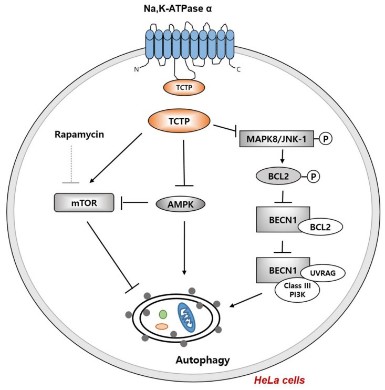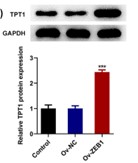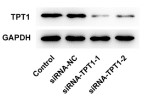TPT1
-
Official Full Name
tumor protein, translationally-controlled 1 -
Overview
Involved in calcium binding and microtubule stabilization. -
Synonyms
TPT1;tumor protein, translationally-controlled 1;HRF;p02;p23;TCTP;translationally-controlled tumor protein;fortilin;histamine-releasing factor
Recombinant Proteins
- Human
- Mouse
- Rhesus macaque
- Rat
- Chicken
- Zebrafish
- E.coli
- Mammalian Cells
- HEK293
- Yeast
- GST
- His
- T7
- Non
- Avi
- Fc
- Flag
- DDK
- Myc
Background
What is TPT1 protein?
TPT1 gene (tumor protein, translationally-controlled 1) is a protein coding gene which situated on the long arm of chromosome 13 at locus 13q14. This gene encodes a protein that is a regulator of cellular growth and proliferation. Its mRNA is highly structured and contains an oligopyrimidine tract (5'-TOP) in its 5' untranslated region that functions to repress its translation under quiescent conditions. The encoded protein is involved in a variety of cellular pathways, including apoptosis, protein synthesis and cell division. It binds to and stabilizes microtubules, and removal of this protein through phosphorylation is required for progression through mitotic and meiotic cell divisions. This gene is known to play a role in carcinogenesis, and is upregulated in some cancer cells. The TPT1 protein is consisted of 172 amino acids and TPT1 molecular weight is approximately 19.6 kDa.
What is the function of TPT1 protein?
TPT1 is involved in calcium binding and plays a role in stabilizing microtubules, which are essential for maintaining cell structure and facilitating cell division. The gene encoding TPT1 is a regulator of cellular growth and proliferation. Its mRNA is highly structured and contains a feature that represses its translation under quiescent conditions, suggesting its involvement in cell cycle control. TPT1 is involved in the response to various cellular stresses, such as oxidative stress, heat shock, and genotoxic stress, and plays a role in DNA-damage repair and cellular autophagy, acting as a cytoprotective protein. Due to its ability to interact with a large number of other proteins, TPT1 is implicated in many core cell biological processes. TPT1 is essential in the early development of both animals and plants, facilitating cell division through stabilizing the mitotic spindle and cell growth through modulating growth signaling pathways.

Fig1. TCTP as a negative regulator of autophagy. (Jiwon Jung, 2018)
TPT1 Related Signaling Pathway
TPT1 is involved in the response to oxidative stress, heat shock, genotoxic stress, ion metabolism imbalance and other cellular stress. TPT1 promotes cell division by stabilizing the mitotic spindle and promotes cell growth by regulating growth signaling pathways. TPT1 is associated with the mTORC1 signaling pathway, which is activated when nutrition is adequate and promotes the anabolic and proliferative state of cells. TPT1 can promote tumor cell proliferation through E2F1, Notch and AKT/mTOR signaling pathways. In the regulation of benign prostatic hyperplasia, TPT1 interacts with miR-216a-5p and mTORC1 signaling pathways.
TPT1 Related Diseases
The TPT1 protein (TCTP) has been implicated in a variety of diseases, especially in the development and progression of cancer. TPT1 is generally expressed at high levels in tumor cells and is involved in a variety of cellular activities including protein synthesis, growth, and cell survival. TPT1 has been identified as a direct target of the tumor suppressor protein TP53/p53. In addition, dysregulated expression levels of TPT1 may contribute to disease progression, especially in cancer, where high levels of TPT1 are often associated with poor outcomes for patients. TPT1 is also involved in the immune response and may tend to promote immunosuppression when cells die. In addition to cancer, TPT1 has been linked to diseases such as acute encephalopathy and chronic urticaria caused by infection.
Bioapplications of TPT1
TPT1 is involved in a variety of cellular stress responses, including oxidative stress, heat shock, genotoxic stress, etc. Tpt1 is an important protein to study how cells respond to stress. TPT1 is highly expressed in a variety of cancers, which is related to tumor growth, invasion and metastasis, and is a potential target for developing anti-cancer strategies. The versatility of TPT1 makes it a potential target for drug development, especially in the development of anti-cancer drugs. TPT1 can interact with a variety of proteins and is an important node for studying protein networks and cell functions.
Case Study
Case Study 1: Haifeng Ni, 2023
Globally, nasopharyngeal carcinoma (NPC) is a prevalent and deadly malignancy. Despite the role of methyltransferase like 13 (METTL13) having been highlighted in a majority of human cancers, its function and mechanism in NPC is indistinct. Corresponding protein expression was measured by western blotting. A chromatin immunoprecipitation assay was applied to verify the association between ZEB1 and the TPT1 promoter. Eventually, to substantiate the critical role of METTL13 in NPC, the establishment of an in vivo tumorigenesis model was accomplished. The results showed that METTL13 positively regulated ZEB1, whereas ZEB1 could bind to TPT1 promoter and transcriptionally regulate TPT1. TPT1 was also found to be upregulated in NPC cells. TPT1 silencing suppressed NPC cellular phenotypes in vitro. TPT1 overexpression partly weakened the anti-tumor effect of METTL13 in NPC.

Fig1. Examination of TPT1 expression with western blotting.

Fig2. Examination of TPT1 expression with western blotting after silencing.
Case Study 2: Jian Zhang, 2020
MiR-216a-5p has opposite effects on tumorigenesis and progression in the context of different tumors, acting as either a tumor suppressor or an oncogene. However, the expression and function of miR-216a-5p in pancreatic cancer (PC) is not well characterized. In this study, researchers found miR-216a-5p was significantly downregulated in PC tissues and cell lines, which showed a negative correlation with peripancreatic lymph, perineural invasion and TNM stage of PCs patients. They made use of functional assays to reveal that miR-216a-5p inhibited growth and migration of PC cells in vitro and in vivo. Then, by employing the bioinformatics analysis and luciferase reporter assay, they demonstrated TPT1 was a potential target of miR-216a-5p, which contributes to tumor malignance by mediating mTORC1 pathway-associated autophagy. Furthermore, bioinformatics analysis and RNA pulldown confirmed that miR-216a-5p was mediated by LINC01133, which sponge miR-216a-5p, as a competing endogenous RNA (ceRNA).

Fig3. Western blot were performed to evaluate the expression of TPT1 in five cell lines.

Fig4. Western blot was conducted to detect the related pathways proteins of TPT1.
Quality Guarantee
High Purity
.jpg)
Fig1. SDS-PAGE (TPT1-4514H)
.
.jpg)
Fig2. SDS-PAGE (Tpt1-615M)
Involved Pathway
TPT1 involved in several pathways and played different roles in them. We selected most pathways TPT1 participated on our site, such as PLK1 signaling events, which may be useful for your reference. Also, other proteins which involved in the same pathway with TPT1 were listed below. Creative BioMart supplied nearly all the proteins listed, you can search them on our site.
| Pathway Name | Pathway Related Protein |
|---|---|
| PLK1 signaling events | ERCC6L,ECT2,SPC24,TPX2,NDC80,BORA,TCTN2,PLK1S1 |
Protein Function
TPT1 has several biochemical functions, for example, calcium ion binding,poly(A) RNA binding,protein binding. Some of the functions are cooperated with other proteins, some of the functions could acted by TPT1 itself. We selected most functions TPT1 had, and list some proteins which have the same functions with TPT1. You can find most of the proteins on our site.
| Function | Related Protein |
|---|---|
| calcium ion binding | PCDH2AB12,HSPA5,TLL2,ACTN2,SPOCK2,PCDH12,NKD2B,CAPN13,NECAB3,PITPNM3 |
| poly(A) RNA binding | NOP56,EIF4G2,SRSF2,MRPL45,HDAC2,PTRF,PYDC3,FASN,ELAC2,DNTTIP2 |
| protein binding | PBXIP1,EPS15L1,RNF31,HACL1,PAG1,EIF4A1,PC,SETBP1,GCKR,UBE2V2 |
Interacting Protein
TPT1 has direct interactions with proteins and molecules. Those interactions were detected by several methods such as yeast two hybrid, co-IP, pull-down and so on. We selected proteins and molecules interacted with TPT1 here. Most of them are supplied by our site. Hope this information will be useful for your research of TPT1.
TP53;TSC22D1;ATP1A1;EEF1D;EEF1D
Resources
Related Services
Related Products
References


